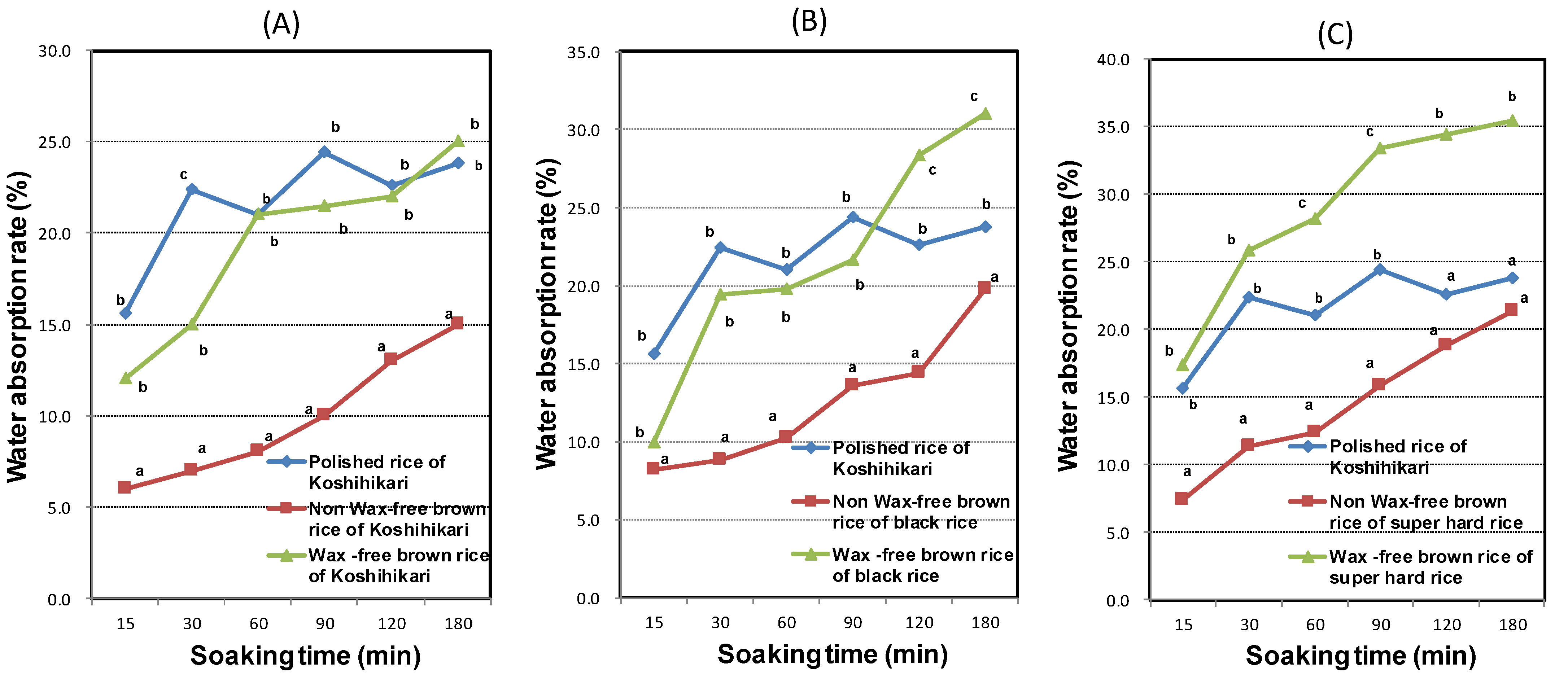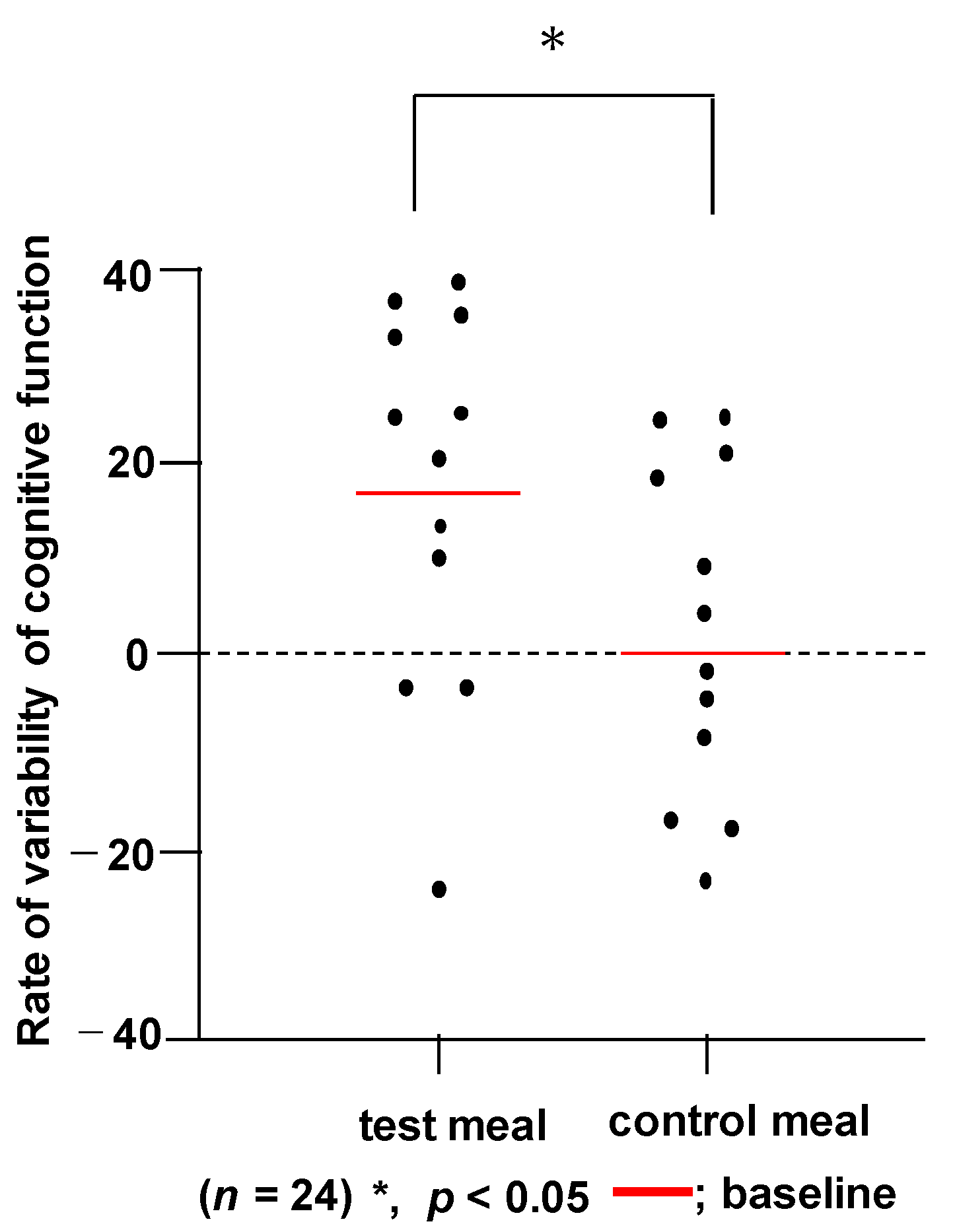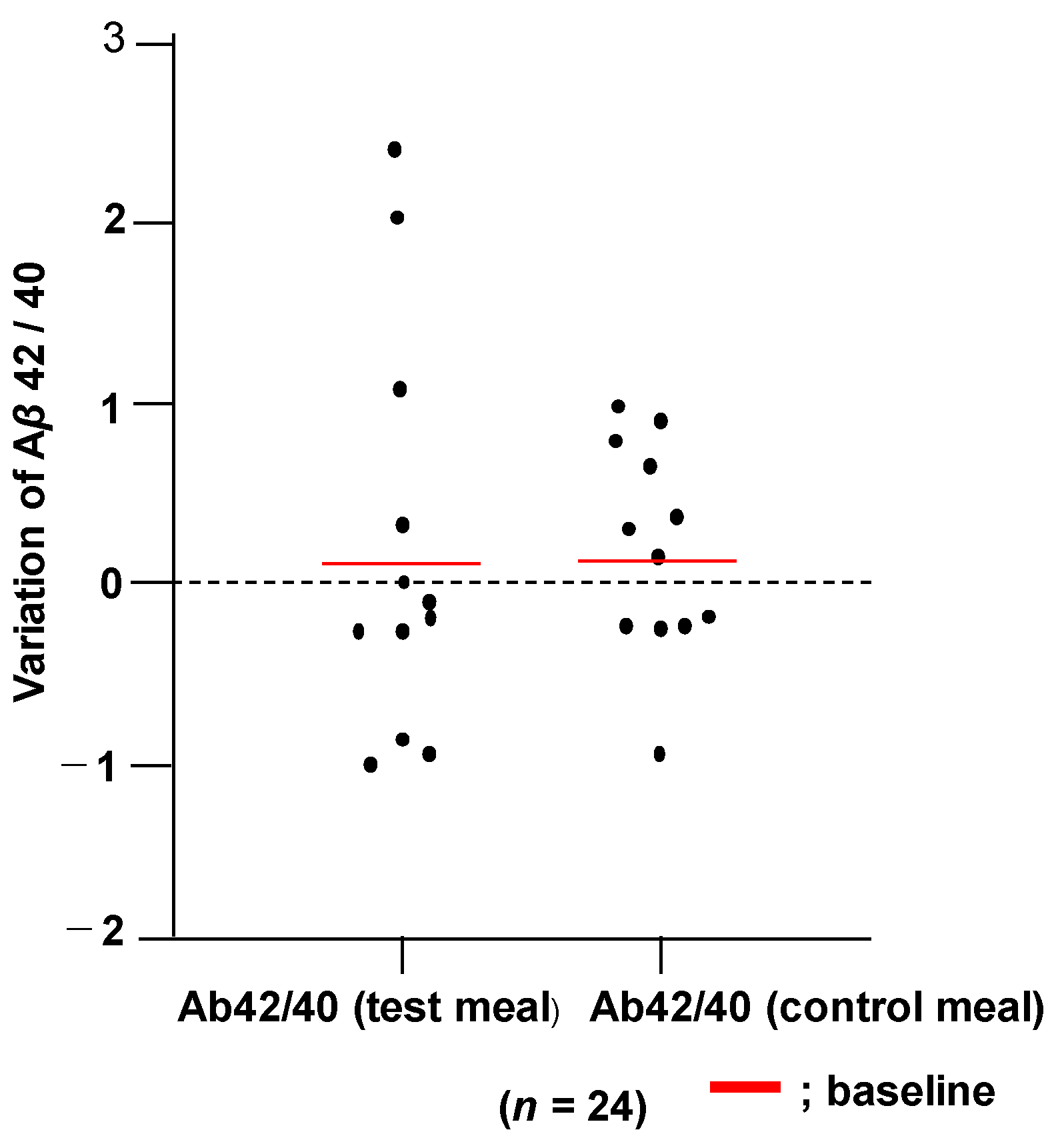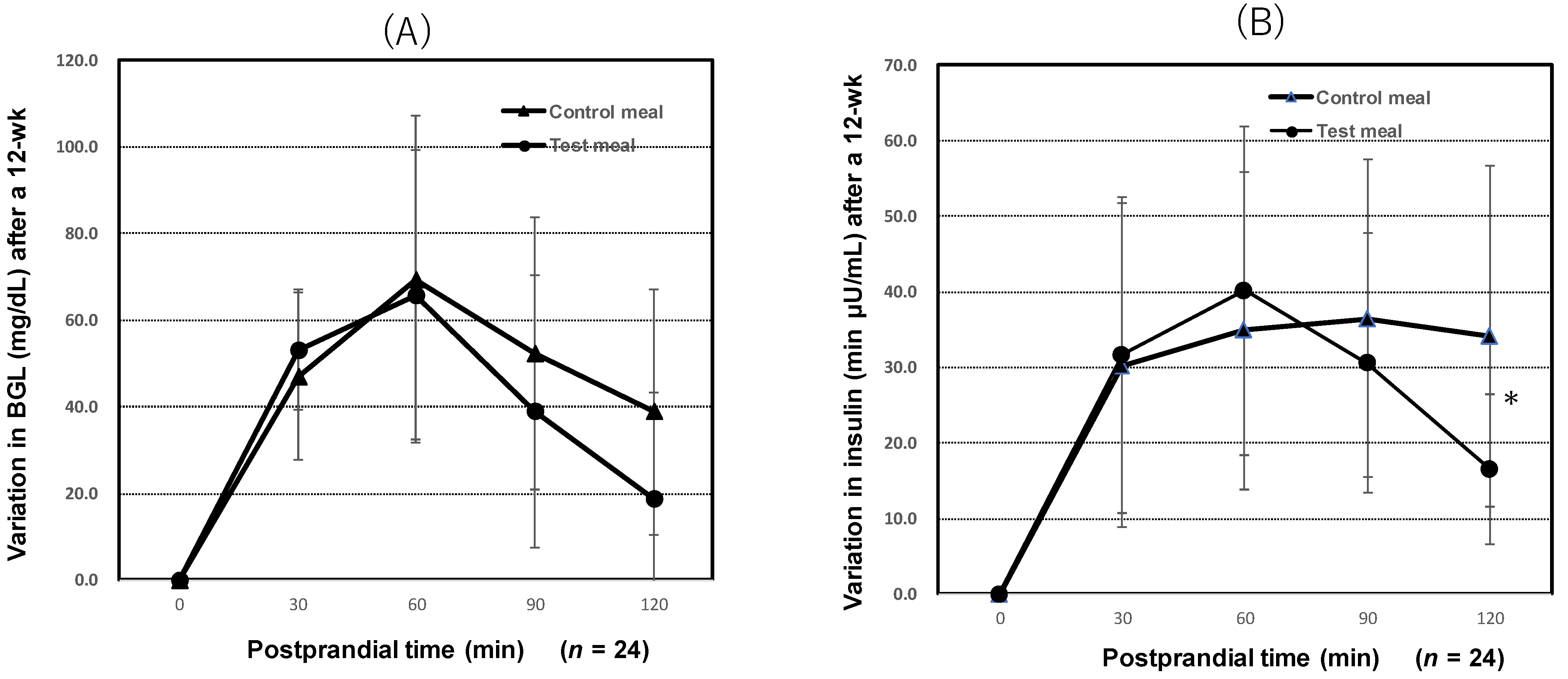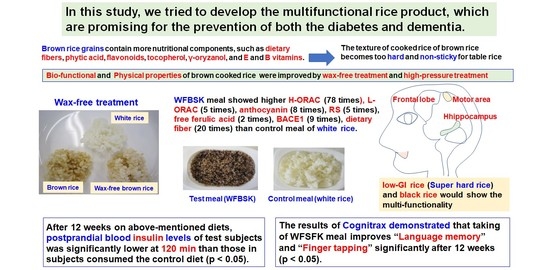1. Introduction
According to a report by the IDF (International Diabetes Federation), about 537 million people were candidates or patients with diabetes in 2021 [
1] and the number of patients with dementia was about 46 million in the world in 2015 [
2].
Dementia is a syndrome where there is deterioration in cognitive function that leads to impairment of the activities of daily living (ADL). Dementia may be caused by a variety of diseases and injuries that primarily or secondarily impair the brain function. Among the dementia patients, most have Alzheimer’s disease (AD); 60–70% of the patients with dementia suffer from AD [
3]. Nowadays, dementia is ranked as the seventh main cause of death among all diseases. Furthermore, it tends to lead to the disability and dependency of aged people all over the world [
3]. Cognitive function consists of multiple domains such as memory, attention, language and executive function, all of which are essential for our daily life [
4]. Cognitive disabilities caused by dementia negatively affect the quality of life (QOL) of elderly patients [
5].
It is well-recognized that the prevalence of dementia is higher in diabetic patients than in non-diabetic subjects [
6].
There are many scientific reports about the close relationship between insulin resistance and lifestyle diseases, such as type 2 diabetes and dementia [
7,
8,
9,
10,
11,
12,
13,
14]. As patients with diabetes have been markedly increasing in number worldwide, the development of a suitable method for its treatment or prevention is very important. The World Health Organization (WHO) and Food and Agriculture Organization of the United Nations (FAO) recommend foods with a low glycemic index (GI) to prevent diabetes [
3]. The concept of GI was introduced by Jenkins et al. [
15], and low GI and glycemic load diets have become popular to prevent chronic diseases, such as cardiovascular disease, diabetes, cancer and obesity [
16], although they all have limited efficacy.
Early intervention for maintaining cognitive function is one of the important factors for successful aging [
17]. To investigate dementia patients, the human intervention test is indispensable. Dubois et al. [
18] described multi-component interventions targeting several risk factors simultaneously, such as “FINGER”, might be needed for optimal preventative effects, to improve and maintain cognitive functioning.
Many researchers reported that the progression of cognitive decline may be considerably affected by various lifestyle factors, such as foods and drinks [
4]. For example, it was reported that cognitive decline was prevented by food components such as minerals, polyphenols, flavonoids, vitamins, omega-3 PUFAs, etc. [
19].
Findings from prospective studies suggest that greater adherence to the Mediterranean diet may be associated with slower cognitive decline and reduced risk of AD [
20,
21]. Core et al. [
22]. showed that reduced levels or intake of omega-3 fatty acids or fish are associated with increased risk of age-related cognitive decline or dementia such as AD.
Rice (
Oryza sativa L.) is one of the most important crops, cultivated in over 100 countries around the world, and is a staple food for about half of the world population [
23]. As rice consumers, especially Asian people, eat it almost every day, it is very promising that its biofunctionality, such as prevention of diabetes and dementia, would be very effective. Unpolished rice grains contain more nutritional components, such as dietary fibers, phytic acids, flavonoids, tocopherols, γ-oryzanol and E and B vitamins, than ordinary milled rice grains [
24]. The germ and bran layers (about 10% of a rice kernel) removed during the milling procedure are rich in proteins, lipids (γ-oryzanol, ferulic acid, sterol, wax, ceramide, phytin and inositol), fiber, minerals, tocotrienols, tocopherols and B-complex vitamins (B1 and B6) [
24]. The use of rice bran as food and feed from 1970 to 1998 was recently reviewed, concerning the control of chronic degenerative diseases such as hypercholesterolemia [
25]. Juliano showed that stabilized rice bran is mildly crunchy and slightly sweet, and has a mild toasted aroma [
25].
The glycemic effect of food depends on numerous factors such as the microstructure of starch, amylose content and amylopectin chain-length distributions [
26,
27]. In a previous study, we developed a novel method for inhibiting postprandial blood glucose levels in Sprague–Dawley rats by preparing cooked rice grains from amylose extender (
ae) mutants of rice soaked with functional food ingredients [
28,
29]. Several studies have reported the development of highly resistant starch rice as well as high-amylose and high-dietary fiber rice via physical or chemical mutation [
30,
31]. The cooked grains of super-hard rice cultivars are hard and non-sticky because they lack starch branching enzyme IIb and contain many super-long chains (SLCs) [
29]. They are promising in terms of their biofunctionality, such as diabetes prevention and reduction of obesity [
32]. Pigmented rice contains polyphenol substances, such as anthocyanins and tannins. Black or purple rice gets its color from anthocyanin pigments, which are known to have free-radical scavenging and antioxidant capacities [
33]. Black rice may have antiatherogenic activity and may improve certain metabolic pathways associated with diets high in fructose [
34,
35]. Red rice is known to be rich in minerals, such as iron and zinc, while black and purple rice are especially high in protein, fat and crude fiber [
34].
The cooked grains of unpolished rice are too hard and non-sticky for the consumers. For that reason, Watanabe et al. [
36] showed that wax-free brown rice (WFBR), which is unpolished rice with only the wax layer removed, keeping other nutrients in the bran layer, is promising for a low-GI and high dietary fibers and vitamins, and its taste is improved. Furthermore, high-pressure treatment (HPT) is very useful in the food industry [
37]. The merits of the high pressure are to avoid the destruction of covalent bonding and to keep the natural flavor, taste, and nutrients. HPT is the technological process that has the least effect on heat-labile water-soluble vitamins, thus contributing to the preservation of the nutritional quality of foodstuffs [
38]. HPT was reported to be useful for improving the texture of cooked rice without denaturation of enzyme activities, and it led to an increase of free amino acids and change in enzyme activities [
39].
The objective of this study was to develop multifunctional boiled rice, which would be useful for preventing type 2 diabetes and dementia, using black rice and super-hard rice with the aid of HPT and wax-free treatment. The antioxidative capacity of black rice and low-GI of super-hard rice would contribute to preventing the onset of diabetes and dementia.
2. Materials and Methods
2.1. Materials
The brown rice of super-hard rice cultivar Niigata 129 go (not registered), the high-quality rice Koshihikari; (registration number in Japan; 8539), waxy black rice Shiho (registration number in Japan; 11846) and black rice Okunomurasaki (registration number in Japan; 11088), were cultivated by the Niigata Prefecture Agriculture Research Institute in 2020, and red rice (Beniroman) and waxy red rice (Yuyake mochi) were purchased from a local market. The wax-free brown rice was manufactured by Toyo Rice (Co., Ltd., Wakayama, Japan) in 2020.
2.2. Preparation of Waxy Black Rice Bran
The bran of waxy black rice (Shihou cultivar) was prepared by polishing using an experimental friction-type rice milling machine (Yamamoto Seisakusyo Co., Tendo, Japan) to a milling yield of 90%.
2.3. Food Processing of Experimental Meal
WFBSK rice (WFBBR:SHBR:KBR = 4:4:2) was combined with 2.5% (w/w) waxy black rice bran (WBB) and 0.3% (w/w) rice oil (Tsuno Food Industrial Co., Ltd., Wakayama, Japan), obtained by treating these at 200 MPa for 2 min in a high-pressure machine (Ishikawajima-Harima Heavy Industries Co., Ltd., Tokyo, Japan), and cooked rice was prepared by Echigo Seika, Co., Ltd. (Nagaoka, Japan). Commercial aseptic cooked rice (using polished rice of high-quality rice cultivar, Koshihikari, as material) was prepared with the same condition with the abovementioned procedure, by Echigo Seika, Co., Ltd., and subjected to the analyses, as well as being used as a control meal in the human intervention test.
2.4. Measurement of Moisture Content of Rice Flour
The moisture content of the brown rice and cooked brown rice were measured using an oven-dry method. Accordingly, 2 g of brown rice sample was dried for 1 h at 135 °C, while 2 g cooked rice samples were dried for 3 h at 135 °C.
2.5. Measurement of Water Absorption Rate (WAR) of Wax-Free Brown Rice (WFBR), Brown Rice and White Rice Grains
Each sample grain (5.0 g) was socked in 50 mL distilled water at 25 °C for 15 min, 30 min, 60 min, 90 min, 120 min or 180 min. After draining, the clear supernatant was removed, and we weighed the sample grains (Wa). The water absorption rate (WAR) was calculated as WAR (%) = (Wa − 5)/5 × 100.
2.6. Textural Properties of Cooked Rice
The physical properties of cooked rice grains were measured based on bulk measurement (10 g), using a My Boy System Tensipresser (Taketomo Electric Co., Tokyo, Japan) according to the method described by Okadome et al. [
40]. For standard samples, milled rice (10 g) was combined with 14 g distilled water (coefficient [gross water volume/dry matter weight]: 1.77, calculated for each sample) in an aluminum cup. After soaking for 1 h, the samples were cooked. The cooked rice samples were kept in the vessel at 25 °C for 2 h and subjected to the measurements. The bulk measurements were repeated five times, and the mean value was calculated.
2.7. Measurement of the Fatty Acid Composition of Rice Bran
Measurement of the fatty acid composition of rice bran was carried out by the Food Analysis Technology Center (using a gas chromatography method). A rice bran sample (0.2 g) was extracted with 2 mL hexane and mixed well. After that, 2 M potassium hydroxide−methanol solution (0.2 mL) was added and mixed.
2.8. Measurement of RS (Resistant Starch) of Cooked Rice
The resistant starch (RS) was measured according to the AOAC method (2002.02) using an RS assay kit (Megazyme, Ltd., Wicklow, Ireland) except the enzyme reaction time. Freeze-dried rice flours (0.1 g) were treated with a 0.1 M sodium maleate (4 mL) (pH 6.0) buffer solution with enzymes (pancreatin and amyloglucosidase) at 36 °C for 6 h, and then denatured ethanol (99%) (4 mL) was added and the solution was centrifuged. The precipitation was mixed with denatured ethanol (99%) (6 mL) and the reaction mixture was centrifuged, and the process was then repeated. The supernatant was removed, and this was followed by the addition of 2 M potassium hydroxide (2 mL), stirred in ice water for 20 min, and 1.2 M sodium acetate (pH 3.8) (8 mL) and amyloglucosidase (0.1 mL) were added and stirred at 50 °C for 30 min in a water bath. After centrifugation, the supernatant (0.1 mL) was mixed GOPOD (glucose oxidase-peroxidase-aminoantipyrine reagent) (3 mL) and stirred at 50 °C for 20 min in a water bath. The glucose content was measured using a spectrophotometer at 510 nm.
2.9. Measurement of Polyphenol Content of Cooked Rice
The polyphenol content of freeze-dried rice samples was determined using the Folin–Ciocalteu method [
41]. Each sample (0.1 g) was extracted with 80% ethanol (4 mL) and then centrifuged. The supernatant (1 mL) was mixed with the same volume of Folin–Ciocalteu solution (1 mL) and incubated for 3 min at room temperature, followed by the addition sodium carbonate (5 mL) and incubation at 50 °C for 5 min. Finally, the sample solution was cooled in ice water for 1 h and then centrifuged. Absorbance was measured at 765 nm. Gallic acid was used for calibration.
2.10. Measurement of Hydrophilic and Lipophilic Oxygen Radical Absorbance Capacity (H-ORAC and L-ORAC)
The hydrophilic and lipophilic oxygen radical absorbance capacities of freeze-dried rice samples were measured as described by Prior et al. [
42]. Trolox calibration solutions were made to obtain a standard curve [
43,
44]. For the hydrophilic antioxidant assay, freeze-dried rice flours (0.1 g) were extracted with hexane (10 mL), and the hexane layer was removed. Residual hexane was evaporated using a water bath at 70 °C, and the residue was then extracted with acetone/water/acetic acid (70:29.5:0.5,
v/
v/
v) (10 mL). The solution was sonicated (Ultrasonic cleaner 3510J-MTH, Branson Ultrasonics Co, Ltd., Richmond, VA, USA) at 37 °C for 15 min, and then centrifuged. The supernatant was diluted to a 25-mL total volume. For the lipophilic antioxidant assay, freeze-dried rice flours (0.1 g) were extracted with hexane (1 mL), and then centrifuged. The hexane was evaporated using a water bath at 70 °C, and the dried hexane extract was then dissolved in acetone (250 μL) and diluted with 7% randomly methylated β-cyclodextrin (750 μL) (RMCD; 0.7 g methyl-β-cyclodextrin (Sigma-Aldrich Co. LLC, St. Louis, MO, USA) dissolved in 10 mL 50% acetone). Absorbance values were measured at 485 nm (excitation) and 530 nm (emission) using a fluorescent microplate reader (Grating Based Multimode Reader SH-9000, Corona Electric Co, Ltd., Hitachinaka-shi, Japan).
2.11. Measurement of the Ferulic Acid Composition of Cooked Rice
Measurement of the ferulic acid composition of rice bran was carried out by the Japan Food Research Laboratories (using microbiological assays and high-performance liquid chromatography–mass spectrometry).
2.12. β-Secretase Inhibitory Activity
The β-secretase (BACE1) inhibitory activity of freeze-dried cooked rice was measured using a BACE1 activity detection kit (Fluorescent; Sigma-Aldrich Co. LLC.). Freeze-dried rice flour (0.1 g) was extracted with 10 mM acetate buffer solution (0.5 mL) (pH 5.0, including 0.1% Triton and 0.05% CHAPS) for 1 h, and then centrifuged. The absorbance values were measured at 320 nm (excitation) and 405 nm (emission) using a fluorescent microplate reader (Grating Based Multimode Reader SH-9000, Corona Electric Co, Ltd.) [
45].
2.13. Measurement of the Dietary Fiber of Cooked Rice
Measurement of the dietary fiber of cooked rice was carried out by the Japan Food Research Laboratories (using microbiological assays and high-performance liquid chromatography–mass spectrometry).
2.14. Measurement of the Anthocyanin Content of Cooked Rice
The anthocyanin content of cooked rice flour was measured based on the pH different method [
46]. Freeze-dried rice flours samples (1.0 g) were extracted with 9 mL methanol/deionized water/trifluoroacetic acid (2:3:0.025,
v/
v/
v) at room temperature for 2 min by strong vortexing. The solution was then sonicated (Ultrasonic cleaner 3510J-MTH, Branson Ultrasonics Co, Ltd.) at 37 °C for 5 min and soaked in a water bath at 37 °C for 10 min, then centrifuged for 2 min at 3000×
g. The supernatant was removed and transferred to a 25-mL volumetric flask. The precipitate was extracted with 8 mL methanol/deionized water/trifluoroacetic acid (2:3:0.025,
v/
v/
v) and the process repeated two times. The supernatant was removed to a volumetric flask and diluted to a 25-mL total volume, and the solution was twofold diluted with pH 1.0 buffer (0.025 M potassium chloride) and another pH 4.5 buffer (0.4 M sodium acetate). The absorbance was measured at 520 nm and 700 nm. The anthocyanin content was expressed as the cyanidin 3-glucoside.
2.15. Sensory Evaluation
The sensory test was carried out by the method reported in our previous paper [
47]. Seven-grade ranking was used to evaluate the six attributes, such as appearance, aroma, hardness, taste, stickiness, and overall evaluation by 10 trained taste panelists.
2.16. Study Design of Human Intervention Test
The study protocol for human test subjects was approved by Niigata Bio-Research Park Inc (Niigata, Japan). and approved by the ethics committee for human tests of the Niigata Bio-Research Park and Niigata University of Pharmacy and Applied Life Sciences, and according to the 2014 guidelines issued by the Ministry of Education, Culture, Sports, Science and Technology and the Ministry of Health, Labor and Welfare, Japan. Informed consent was obtained for experimentation with human subjects, and the test was registered as UMIN000044767.
A randomized, parallel-group comparison study was conducted to examine the effect of WFBSK rice. Inclusion criteria were as follows: (1) subjects aged from 50 to 75 years, (2) not diagnosed as having dementia or diabetes, (3) no consumption of supplements that may affect cognition or blood glucose. We recruited 24 healthy subjects for the study. The effect of WFBSK rice on cognitive performance was the primary endpoint. Secondary endpoints included inhibition of abrupt increase in postprandial blood glucose level and change in plasma amyloid-β (Aβ) 42/40 ratio.
Components of the test and control meals are shown in
Table S1. Participants were randomly assigned to one of two groups. Subjects of each block-consumed the assigned test sample meal (one package of boiled rice) containing 64 g (test meal) or 67 g (control meal) carbohydrate once every day for 12 weeks consecutively. After 12 weeks, test subjects got the single-dose test for BGL measurements, where they consumed the assigned meals within 10 min with frequent mastication (30 times was the guideline) and 200 mL of water.
2.17. Evaluation of Cognitive Function
The Mini-Mental State Examination Japanese version (Nihon Bunka Kagakusha, Tokyo, Japan) was evaluated at the baseline. The Cognitrax test (Health Solution, Inc., Tokyo, Japan) was utilized to assess the cognitive change by intervention. Cognitrax consists of a computerized test battery, which evaluates multiple cognitive domains, including composite memory, verbal memory, visual memory, processing speed, psychomotor speed, executive function, reaction time, complex attention, simple attention, cognitive flexibility and motor speed. Cognitrax scores have been standardized according to the results from large populations of subjects aged from 7 to 90 years [
48].
2.18. Measurement of Plasma Concentrations of Aβ1-42 and Aβ1-40
Plasma concentrations of Aβ1-42 and Aβ1-40 were analyzed using a V-PLEX Aβ Peptide Panel 1 (6 × 1010) Kit (Meso Scale Discovery, Rockville, MD, USA) with MESO QuickPlex SQ 120 (Meso Scale Diagnostics, LLC, Rockville, MD, USA) according to the manufacturer’s instructions. The intra-assay and inter-assay coefficients of variation were less than 20% for all assays.
2.19. Blood Examination
Blood was drawn (in November 2021) under fasting conditions from each subject for analysis of Aβ40, Aβ42, HDL cholesterol, LDL cholesterol, insulin sensitivity and HbA1c. Plasma concentrations of Aβ1-42 and Aβ1-40 were analyzed using a V-PLEX Aβ Peptide Panel 1 (6 × 1010) Kit (Meso Scale Discovery, Rockville, MD, USA) with MESO QuickPlex SQ 120 (Meso Scale Diagnostics, LLC, Rockville, MD, USA) according to the manufacturer’s instructions. The intra-assay and inter-assay coefficients of variation were less than 20% for all assays. BGL and insulin levels were measured at 0, 30, 60, 90 and 120 min after two groups of 12 subjects who had eaten two different test meals.
2.20. Statistical Analyses
All results were subjected to t-tests and Dunnett’s test using Excel Statistics (version 6, Microsoft Corporation, Tokyo, Japan) and GraphPad Prism V8.4.3 (GraphPad Software, Inc., San Diego, CA, USA). A value of 0.05 < p < 0.10 was considered to show the tendency, and a value of p < 0.05 was considered to be statistically significant.
